Georgia Grown Produce
June 1, 2017 | 16 min to read
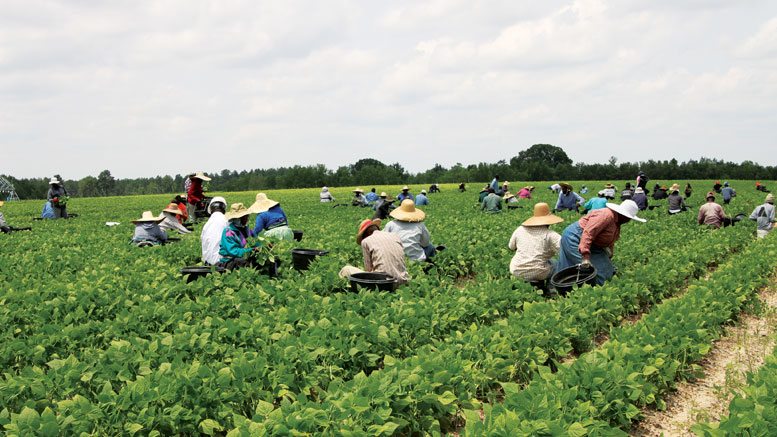

Critical to Spring, Summer and Fall supplies the state promotes the variety of produce it grows and markets to retail and foodservice buyers
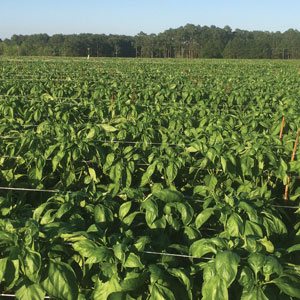
Georgia’s agriculture plays a major role in the state’s economy.
As demand for local produce booms, Georgia growers produce a variety of fresh crops that help one of the leading vegetable-producing states satisfy consumer demand for local and regional product.
The Peach State is well-known for growing its signature item and maintains an international reputation for Vidalia onions, the biggest-producing sweet onion. However, the state grows a variety of fruits and vegetables. It is ranked second nationally for sweet corn and third for peaches. Georgia is also the third leading producer of fresh bell peppers, cucumbers, green beans and watermelon, according to the U.S. Department of Agriculture. In recent years, increased plantings have helped the state soar to the largest southeastern producer of blueberries and the country’s third biggest. Georgia is fifth in cabbage and squash, and sixth in tomatoes. It also grows carrots and sweet potatoes.
Georgia’s window typically begins by late April with blueberries, cabbage, squash and Vidalia onions. Others, including peaches, bell peppers, cucumbers, eggplant, sweet corn and green beans, usually follow in May. Watermelon and cantaloupe production starts in June, while growers begin harvesting the bulk of their leafy greens in mid-September with production running through June. Tomatoes usually start in June and return in October.
Growing Local Interest
As people are farther removed from their agricultural roots, interest in local and agritourism is expanding. There is a larger movement of people wanting to see how food grows. Helping Georgia growers market their crops is Georgia Department of Agriculture’s (GDA) Georgia Grown marketing program. “What makes Georgia Grown products attractive is that consumers are beginning to realize this is a diverse state that can produce many things and produce high-quality products,” says Georgia Agriculture Commissioner Gary Black.
Black points to the state’s 265 frost-free days a year, its high supply of water, productive land and strong land grant university system as helping production. He also notes the natural resource pressures affecting Florida and California growers. “That makes us (Georgia) Ground Zero for the real growth of the fruit and vegetable industry, and really for agriculture as a whole,” says Black. “The more retailers can do to build the relationship between Georgia farmers and their customers will help. If they don’t take advantage of building that relationship, they’re missing marketing opportunities that run quite deep.”
Retailers enthusiastically promote Georgia produce. Grower-shippers and state officials cite Kroger, Publix, Wal-Mart, Southeastern Grocers’ Winn-Dixie, Harvey’s and Bi-Lo stores, Ingles and Piggly Wigglys as chains that do well promoting Georgia Grown. Stores erect lots of signage in their produce departments trumpeting the arrival of local produce, observes John Williams, sales and marketing director of L.G. Herndon Jr. Farms Inc., headquartered in Lyons, GA. “They all do a good job of letting the consumers know where all the produce is coming from,” he says.
Georgia Focus
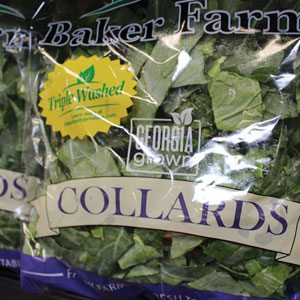

Georgia ranks fifth as the second-largest grower of collard greens.
(Photo Courtesy of Georgia Department of Agriculture)
Herndon includes the Georgia Grown label on its packaged leafy greens, including kale and collards, sweet potatoes and Vidalia onions. The company features a description of the farm on the back of the package to educate shoppers on the grower and the product’s origin. Shoppers, particularly Millennials and those in their 30s, want to know their food is clean and where it originates. The Georgia Grown label also provides meaning to shoppers in other states, as they like to know the products aren’t some kind of “generic, global thing,” says Williams.“When consumers know it’s local, it means a lot to consumers and the people that are selling it to their customers,” he says.
Steve Mullis, owner and president of Farmer Johns, an Alma, GA-based grower of blueberries, which markets through the Watsonville, CA-based Dole Berry Co., lauds Kroger for its Georgia Grown commitment. The retailer merchandises Georgia products with lots of signage and other materials promoting the local produce. “They do a lot of in-state promotions for local grown,” he says. “They do impressive displays and are a big advocate of Georgia products. They support local grown products heavily.”
Consumers’ comfort with products drives local interest, says Duke Lane III, partner with Fort Valley, GA-based Genuine Georgia Group. “Consumers feel they have some intuitive knowledge of a product,” he says. “When their local peaches are not in season, we have seen a lot of retailers promote Georgia peaches, which are almost perceived as local in many areas.” Genuine Georgia, which also markets pecans, offers retailers customized marketing packages. Like children, no child is the same. Every retailer the organization works with uses its own formula. The shipper’s job is to listen to the retailer and determine what’s important to them, says Lane.
Georgia On My Mind
Adding “Georgia” to the generic “peaches” word in retail displays has helped increase sales. When retailers make that change, sales significantly increase, says Will McGehee, marketing director for Georgia Peach Council, Macon, GA. It is difficult to say much in tiny price look-up stickers, but retailers do well in using other materials to promote a growing region’s product. “We plea with our retailers to get the message to produce managers to take that story of Georgia peaches to their customers,” McGehee says. “They can do that with hand-written chalk boards, pre-printed displays or something simple. We have lists dozens long of people who testify as soon as they put Georgia on display, sales spike. Everyone is trying to get the customer who buys one pound to buy two pounds. Here’s how we can get more fruit through the registers by using something so simple and easy as calling out Georgia, which has had great success.”
Peach production is increasing to accompany larger local and regional interest. “New acreage hasn’t slowed,” says McGehee. “We are enjoying an increase in acreage that was planted three to four years ago, when the local movement started gaining a lot of steam. It’s growing 10 to 15 percent every year.”
Calling attention to other Georgia produce also helps sales. “Many retailers will call out produce from Georgia using the Georgia Grown logo and signage,” says John Shuman, president of Shuman Produce Inc., in Reidsville, GA. “This gives consumers peace of mind knowing where their food is produced and is a built-in marketing tool at the retail level in both displays and ad call-outs.” Shuman Produce wants retailers to increase sales by merchandising Vidalia onions alongside complementary products that can attract shoppers’ attention.
Vidalia onions are unique because they can legally only be grown in a 20-county region in southeast Georgia. “Vidalia onions are one of the few produce items that have an affinity tied to a specific and small geographic region, you just can’t grow them anywhere,” says Shuman.
The GDA has constructed a community of producers, suppliers, retailers and consumers all interested in promoting local quality products, as well as providing resources for new agribusinesses, says Lauren Dees, marketing manager for Generation Farms, headquartered in Lake Park, GA. Generation Farms grows and ships Vidalia onions, green beans, sweet potatoes, carrots, kale, blueberries, watermelon and organics.
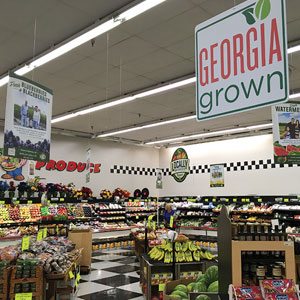

Photo Courtesy of Georgia Department of Agriculture
Retailers have upped their game in local and regional promotions. “Marketing locally grown produce is essential not only for consumer awareness, but also for buyers who are often unaware of the availability and source from other regions when they could offer a higher quality product,” she says. “In the past five years, retailers have increased their marketing efforts for Georgia Grown products, and I believe we will only see this trend increase. Retailers who want to promote Georgia Grown need to know what products are available locally and source those items year-round when possible so that consumers rely on their store for Georgia Grown needs.”
Local helps market Georgia watermelons. “Georgia watermelons play well with local demand,” says Greg Leger, president and owner of Leger & Son Inc., which ships from Cordele, GA. “People, especially those in the Atlanta area, look for Georgia Grown. I can’t say they won’t pick up a watermelon from somewhere else and not buy it, but when that Georgia Grown marketing hits, they like to purchase them. We have people tell me they wait until they start seeing the local product.” One way Leger works to provide ideal eating experiences is by not rushing harvesting. The company waits until the fruit is at peak flavor and quality so shoppers return and purchase more.
Marketing Opportunities
L&M in Raleigh, NC, promotes Georgia Grown vegetables through a variety of packaging, including labels, trays, bag clips, paper and poly bags, tote bags, bins and half bins, display tables and display-ready cartons. It uses a combination of its own artwork, as well as photographs and logos supplied by state agriculture departments, says Lee Anne Oxford, director of marketing. L&M provides customers with print ads, photos and local farm stories, and works to keep local farms and programs producing to provide the longest local season possible for its customers.
The local trend is growing. “Retail, foodservice and wholesale companies all value local support on a wide range of products,” says Oxford. “Local and regional produce and promotions are very important to our customers and their customers. We find that a wide variety of consumers love local produce and supporting their local farms.” Those customers include small local stores, national retailers, institutions and quick-service and white tablecloth restaurants. L&M markets a variety of vegetables and is experimenting with new items.
Southern Valley Fruit & Vegetable Inc., based in Norman Park, GA, promotes its bell peppers, cucumbers and squash through social media. It identifies Georgia product through the #GeorgiaGrown hashtag. Labeling all boxes with the Georgia Grown logo shows retailers, foodservice and wholesale customers they are buying a Georgia Grown product.
Customer interest is high when Georgia is harvesting crops and people specifically seek Georgia product, says Katie Murray, director of marketing. “We think it is very important that consumers are aware and in the know when product is local to the state of Georgia,” she says. “When Georgia’s growing season is in, they don’t want product from Mexico or from some other part of the United States; they want Georgia product and they have the assurance that’s what they’re getting with the Georgia Grown logo on our boxes. More and more people want to know where their food comes from and they want to buy it from a local vendor. Making sure consumers are aware the product is Georgia Grown is very important as to whether or not it is a product they will choose to buy, specifically during certain times of the year when they know product should be in season.”
Production Rising
The Georgia Grown program has been a big boost for the state’s growers. Demand for Georgia products, as well as lower prices for row crops, including field corn and soybeans, has helped Georgia growers transition to growing more specialty crops. The state produces more diverse crops, including more vegetables, says Delbert Bland, president of Bland Farms, LLC in Glennville, GA. Georgia’s favorable climate and water also helps. “When you look at where food is produced in the United States as far as vegetables, there many people on the East Coast during our window, so we have one of the earliest they can get fresh produce,” he says. “The key is finding commodities good for this area as far as growing conditions. Growers then must be willing to spend the time and money on it and do a good job packing quality product for the retail buyers.”
Bland estimates it ships about 10 percent of its Vidalia onions to Georgia customers, primarily Atlanta retailers and wholesalers. Of those shipments, many truckloads go to supermarkets in surrounding states. “If you get to the truth of the matter, consumers would come closer to telling you if it looks good and is fresh — they’re more concerned about that than what state the product is grown in,” he says. Bland prefers to term his Vidalia production local grown but nationally marketed. “We have some retailers that do excellent jobs promoting Georgia while some have a lot of work to do,” he says. “Without calling names, I think all the stores could do a better job promoting Georgia products.”
Distributing Produce
Phoenix Wholesale Foodservice Inc., and sister retail operator Collins Bros. Corp., updates the numerous casual and white tablecloth restaurants and supermarkets it services throughout Georgia and parts of Alabama, South Carolina and Tennessee about the availability of seasonal products through a weekly newsletter. Popular Georgia items include herbs, leafy greens, cabbage, bell peppers, cucumbers, squash, Vidalia onions, sweet corn, green beans, peas, blueberries, blackberries, peaches and watermelon.
David Collins III, president of the Forest Park, GA-based Phoenix, says interest is high. “The Georgia Grown program is really growing,” he says. “We are really ramping it up. We are getting a tremendous amount of push toward it. Many restaurants and hotels are pushing and promoting local grown products. It’s being embraced by corporate America.” Collins says increased sales of Georgia produce help local economies and feed consumers’ renewed interest in sustainable agriculture.
The Atlanta-based Nickey Gregory Co., LLC markets Georgia produce via a special price list it sends to customers alerting them to product availability. Andrew Scott, director of marketing and business development, recommends retailers place cut samples near displays for taste testing. They should also cut product in half, particularly melons, so shoppers can view the fruits’ interior. “Georgia retailers do a very good job of promoting Georgia Grown during the spring and fall,” says Scott. “A couple of retailers have posters of the farmers next to their products in the grocery stores. That provides a nice personal side to farming.”
Restaurant usage is increasing, says Generation Farms’ Dees. Restaurants are using more Georgia Grown produce seasonally, including fresh fruit in salads, hearty vegetables in soups, sautéed onions and proteins, which creates an experience for customers where they are more cognizant of the fresh flavors and attention to detail, she says.
Opportunities
Jaemor Farms in Alto, GA, grows peaches, apples and vegetables. It planted six additional acres of strawberries for Atlanta’s Royal Food Service Inc., to distribute to schools and institutions. The GDA cites its work in building grower-distributor relationships. “Royal sold all the strawberries before it moved a flat,” says Black. “Now, students are enjoying Georgia strawberries for the first time. That’s a direct six acres of strawberries that were never planted before and had never entered the tummy of a Georgia student. We are in the stage of this program where we’re getting the flywheel to turn over. With this momentum, we will reach a point to where all we have to do is get out of the way.”
Herndon’s Williams participates in school foodservice events where cafeterias and dietitians invite growers to participate in Georgia Grown days or during times Georgia products are featured on school menus. Williams also attended a school nutritionists conference in Atlanta, which included a tradeshow showcasing the state’s many foods and agricultural products for school personnel. “We can’t do all of those shows, but we like to be a part of how they’re trying to promote Georgia products on their menus,” he says. “We love touching our customers. They seem to really enjoy meeting us and visiting a real grower who grows their food. It’s really important to them.”
Celebrating Farmers and Local
Supermarkets and chefs rely on Georgia Grown produce.
By Doug Ohlemeier
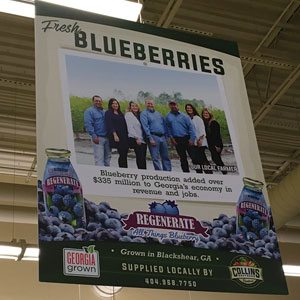

Photo Courtesy of Georgia Department of Agriculture
Supermarkets and restaurants enjoy promoting Georgia Grown product. When growers are in season, packages of Southern vegetables and blueberries, peaches and watermelon fill supermarket shelves and are featured on restaurant menus. Georgia produce provide sa great way for the stores and eateries to differentiate themselves from others.
Georgia produce is a key part of produce offerings at Lakeland, FL-based Publix Super Markets Inc., which operates from 184 Georgia stores. Signage in the produce department promotes local produce availability. Additionally, the chain’s At Seasons Peak program reminds shoppers of the seasonality of the fruits and vegetables they buy. “As consumers, we have grown accustomed to year-round availability. However, we want our customers to know the peak of season for the produce they are purchasing,” says Maria Brous, director of media and community relations. “Locally grown produce is very important to us at Publix, and it benefits our customers as well. ‘Local’ means something different to each person, but to us, it means sourcing as close to home as possible, within our operating areas.”
Georgia product is critical for Piglet Supermarket in Soperton, GA. The store, which is part of Cordele, GA-based RuBo’s-Piglet, runs large displays promoting Vidalia onions, watermelon and other Georgia produce, says Ricky Reese, produce manager. “If it’s a hot item, we will run it about twice as big in terms of space than we normally do,” he says. “We like to double-up on it. We try to push it (Georgia produce) more and buy more of it than we do of any other option or growing region. We want to support it and help out the local economy because a lot of them buy from us as well.”
Atlanta’s Nickey Gregory Co., LLC, which distributes produce throughout the southeast, supplies Atlanta foodservice distributors. “We send them weekly Georgia Grown pricing when in season. Georgia produce has become very popular for their customers/restaurants,” says Andrew Scott, director of marketing and business development.
Forest Park, GA-based Phoenix Wholesale Foodservice Inc., delivers Georgia produce to numerous casual and white tablecloth restaurants within a 200-mile radius of Atlanta. “Retailers and restaurants, they’re embracing it,” says David Collins III, Phoenix’s president. “We have more and more interest from people wanting to expand their programs. There’s tremendous movement in the push for local grown.”
At the Hyatt Regency in Atlanta, local foods are important menu items. The restaurant promotes local produce on its menus, and chefs speak to guests about available Georgia items. A well in the restaurant’s show kitchen displays products it procured that day from the nearby Peachtree Road Farmers Market. The restaurant purchases Georgia asparagus, collards and other greens, peaches, strawberries, sugar snap peas, swiss chard, tomatoes, as well as African-style squash. Specialty items include purple and watermelon radishes, hakurei turnips and wild ramps foraged from north Georgia.
Offering local products is no longer optional, says Thomas McKeown, executive chef. “It’s no longer a food trend. It’s got to the point to where customers expect us to use as much local as we can,” he says. “If they’re not seeing it, they get concerned. It’s nice to have gone from an amazing trend to a must-have item.” Because local products offer freshness and flavor, chefs don’t have to work as much with, or mask the flavors, of items when they taste well, he says.
The local trend is increasing, observes McKeown. “Atlanta is a hotbed for sustainability and sustainable farming,” he says. “Every chef producing in Atlanta is doing local. It has become a common theme throughout the city. It’s so readily available, so it makes sense to do local.” McKeown points to the state’s many young and well-established growers.
On Georgia’s coast, the St. Simons Island, GA-based Halyard Restaurant Group, which operates Halyards, an upscale seafood place, and Tramici, a casual pizza and pasta eatery, has been promoting Georgia produce long before the trend became popular. “We try to accentuate Georgia products and serve them whenever we can,” says Dave Snyder, owner and executive chef. “If you want to serve the best, you have to buy the best. We want to make sure that people know. For some restaurants, like chains, it’s not important at all. We spend a lot of time making extra phone calls and sending emails through the week to try to see if we can get it. We can compete with other restaurants doing that. For us, it’s worth our time, energy and effort to get it.”
Halyard purchases baby vegetables, herbs, Vidalia onions, lettuces, kale, potatoes, tomatoes, field peas and corn. Four farms supply products six months out of the year while two supply throughout the year. The restaurant lists the local farms it sources product from on the bottom of the menu’s front page. Servers also discuss the local ingredients.
The three driving forces are customers who care about health, flavor and expense. Some diners feel more comfortable knowing where the food originated and if it is organic or all-natural. Others want to support local businesses and are pleased when they hear money taken from the guest is spent in the country or a surrounding county, while others prefer taste. “A vine ripe tomato just tastes better, we all know that,” says Snyder. “We are willing to spend an extra 10 percent to 15 percent above others offered by the mainstream companies that call on us.”
In southeast Georgia, in the heart of Vidalia onion country, Elements Bistro & Grill in Lyons, GA, is an upscale steakhouse and seafood restaurant. The restaurant purchases from several local growers. An area greenhouse helps provide product during the off-season. It tries to serve local Georgia products throughout the year, but that can be tricky, says Richard Nanney, executive chef. “Serving Georgia products is very important,” he says. “It keeps the community growing. It helps promote interest in the food and menus. To see people familiar with companies in the community being utilized keeps it centralized in the local area. It helps a lot with business because they’re familiar names attached to the items.”
Elements’ staff tells patrons about local foods. Notifying customers is critical. The restaurant tries to educate customers when product is available and the type of products it serves, says Nanney. Vidalia onions are popular, of course, as well as Georgia lettuce, chard, kale, spinach, beets, blueberries and strawberries. The restaurant hosts quarterly wine tastings, which include regional ingredients to support seasonal themes. Adding different twists on the food served with the libations, Elements tries to replicate cuisines accompanying the wines using local ingredients.
“I see the local trend increasing,” says Nanney. “I have worked in Atlanta and Savannah. In my experience here, customers usually respond well to it. When we do feature local, it does seem to get a better response.”
Food Safety Challenges
Produce Food Safety Services, a division of the LaGrange, GA-based Georgia Fruit & Vegetable Growers Association, has begun receiving requests from retailers seeking assistance in sourcing local produce from growers that have achieved food safety certification. Beth Oleson, the association’s director of education and food safety, says the organization is able to recommend those that meet or meet a portion of federal food safety requirements.
While the larger commercial grower-shippers have long adapted food safety regulations, today’s attitude among the smaller growers isn’t out of sync with their larger competitors, says Oleson. While the Food Safety Modernization Act (FSMA) may exempt some smaller operations, retailers in the marketplace want third-party audits. “We are finding most of the small growers have the same attitude the larger growers have,” she says. “‘Tell me what I need to do and I will do it’. The smaller growers have been chomping at the bit for several years since we started talking about FSMA. We have been working with our membership, as well as other organizations around the state to develop education tools, create workshops and do a lot of one-on-one farm safety mock audits where we are able to help them see where they’re doing well and areas they need to improve.”
Once growers are able to better understand the regulations and differences between FSMA and third-party audits, they find it easier to act on them, says Oleson. The association is helping the smaller growers develop food safety knowledge via writing safety plans as well as assistance preparation for third-party audits. “The only difference I’m finding in the small guys is that there are a lot of them who may have heard about the concepts of food safety, but may never have had to put them into practice,” she says. “The number of farms getting that message is increasing.”
Georgia’s peach growers are updated on food safety practices. The industry employs a produce safety specialist who developed an audit-ready program for growers and packers. The specialist makes unannounced visits to farms, groves and packinghouses, says Duke Lane III, partner with Fort Valley, GA-based Genuine Georgia Group. “That shows a lot about the importance of food safety to our growers and the cohesion we have,” he says. “As an industry, we have gone above and beyond what’s required. The industry recognizes the challenges of being able to work together to accomplish common goals.”
Article 17 of 22

